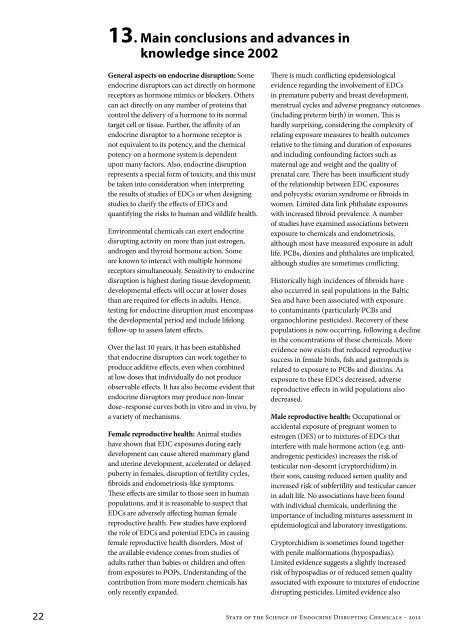Endocrine Disrupting Chemicals 2012 - World Health Organization
Endocrine Disrupting Chemicals 2012 - World Health Organization
Endocrine Disrupting Chemicals 2012 - World Health Organization
Create successful ePaper yourself
Turn your PDF publications into a flip-book with our unique Google optimized e-Paper software.
13. Main conclusions and advances in<br />
knowledge since 2002<br />
General aspects on endocrine disruption: Some<br />
endocrine disruptors can act directly on hormone<br />
receptors as hormone mimics or blockers. Others<br />
can act directly on any number of proteins that<br />
control the delivery of a hormone to its normal<br />
target cell or tissue. Further, the affinity of an<br />
endocrine disruptor to a hormone receptor is<br />
not equivalent to its potency, and the chemical<br />
potency on a hormone system is dependent<br />
upon many factors. Also, endocrine disruption<br />
represents a special form of toxicity, and this must<br />
be taken into consideration when interpreting<br />
the results of studies of EDCs or when designing<br />
studies to clarify the effects of EDCs and<br />
quantifying the risks to human and wildlife health.<br />
Environmental chemicals can exert endocrine<br />
disrupting activity on more than just estrogen,<br />
androgen and thyroid hormone action. Some<br />
are known to interact with multiple hormone<br />
receptors simultaneously. Sensitivity to endocrine<br />
disruption is highest during tissue development;<br />
developmental effects will occur at lower doses<br />
than are required for effects in adults. Hence,<br />
testing for endocrine disruption must encompass<br />
the developmental period and include lifelong<br />
follow-up to assess latent effects.<br />
Over the last 10 years, it has been established<br />
that endocrine disruptors can work together to<br />
produce additive effects, even when combined<br />
at low doses that individually do not produce<br />
observable effects. It has also become evident that<br />
endocrine disruptors may produce non-linear<br />
dose–response curves both in vitro and in vivo, by<br />
a variety of mechanisms.<br />
Female reproductive health: Animal studies<br />
have shown that EDC exposures during early<br />
development can cause altered mammary gland<br />
and uterine development, accelerated or delayed<br />
puberty in females, disruption of fertility cycles,<br />
fibroids and endometriosis-like symptoms.<br />
These effects are similar to those seen in human<br />
populations, and it is reasonable to suspect that<br />
EDCs are adversely affecting human female<br />
reproductive health. Few studies have explored<br />
the role of EDCs and potential EDCs in causing<br />
female reproductive health disorders. Most of<br />
the available evidence comes from studies of<br />
adults rather than babies or children and often<br />
from exposures to POPs. Understanding of the<br />
contribution from more modern chemicals has<br />
only recently expanded.<br />
There is much conflicting epidemiological<br />
evidence regarding the involvement of EDCs<br />
in premature puberty and breast development,<br />
menstrual cycles and adverse pregnancy outcomes<br />
(including preterm birth) in women. This is<br />
hardly surprising, considering the complexity of<br />
relating exposure measures to health outcomes<br />
relative to the timing and duration of exposures<br />
and including confounding factors such as<br />
maternal age and weight and the quality of<br />
prenatal care. There has been insufficient study<br />
of the relationship between EDC exposures<br />
and polycystic ovarian syndrome or fibroids in<br />
women. Limited data link phthalate exposures<br />
with increased fibroid prevalence. A number<br />
of studies have examined associations between<br />
exposure to chemicals and endometriosis,<br />
although most have measured exposure in adult<br />
life. PCBs, dioxins and phthalates are implicated,<br />
although studies are sometimes conflicting.<br />
Historically high incidences of fibroids have<br />
also occurred in seal populations in the Baltic<br />
Sea and have been associated with exposure<br />
to contaminants (particularly PCBs and<br />
organochlorine pesticides). Recovery of these<br />
populations is now occurring, following a decline<br />
in the concentrations of these chemicals. More<br />
evidence now exists that reduced reproductive<br />
success in female birds, fish and gastropods is<br />
related to exposure to PCBs and dioxins. As<br />
exposure to these EDCs decreased, adverse<br />
reproductive effects in wild populations also<br />
decreased.<br />
Male reproductive health: Occupational or<br />
accidental exposure of pregnant women to<br />
estrogen (DES) or to mixtures of EDCs that<br />
interfere with male hormone action (e.g. antiandrogenic<br />
pesticides) increases the risk of<br />
testicular non-descent (cryptorchidism) in<br />
their sons, causing reduced semen quality and<br />
increased risk of subfertility and testicular cancer<br />
in adult life. No associations have been found<br />
with individual chemicals, underlining the<br />
importance of including mixtures assessment in<br />
epidemiological and laboratory investigations.<br />
Cryptorchidism is sometimes found together<br />
with penile malformations (hypospadias).<br />
Limited evidence suggests a slightly increased<br />
risk of hypospadias or of reduced semen quality<br />
associated with exposure to mixtures of endocrine<br />
disrupting pesticides. Limited evidence also<br />
22 State of the Science of <strong>Endocrine</strong> <strong>Disrupting</strong> <strong>Chemicals</strong> – <strong>2012</strong>
















